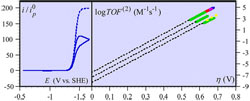Publication
712
J. Am. Chem. Soc. , 134 (27), 11235-11242, 2012
DOI:10.1021/ja303560c
|
|
|
|
|
 |
Turnover Numbers, Turnover Frequencies, and Overpotential in Molecular Catalysis of Electrochemical Reactions. Cyclic Voltammetry and Preparative-Scale Electrolysis |
|
|
|
|
Cyrille Costentin, Samuel Drouet, Marc Robert, and Jean-Michel Savéant
Laboratoire d’Electrochimie Moléculaire, Unité Mixte de Recherche Université−CNRS No. 7591, Université Paris Diderot, Sorbonne Paris Cité, Bâtiment Lavoisier, 15 rue Jean de Baïf, 75205 Paris Cedex 13, France
The search for efficient catalysts to face modern energy challenges requires evaluation and comparison through reliable methods. Catalytic current efficiencies may be the combination of many factors besides the intrinsic chemical properties of the catalyst. Defining turnover number and turnover frequency (TOF) as reflecting these intrinsic chemical properties, it is shown that catalysts are not characterized by their TOF and their overpotential (η) as separate parameters but rather that the parameters are linked together by a definite relationship. The log TOF−η relationship can often be linearized, giving rise to a Tafel law, which allows the characterization of the catalyst by the value of the TOF at zero overpotential (TOF0). Foot-of-the-wave analysis of the cyclic voltammetric catalytic responses allows the determination of the TOF, log TOF−η relationship, and TOF0, regardless of the side-phenomena that interfere at high current densities, preventing the expected catalytic current plateau from being reached. Strategies for optimized preparative-scale electrolyses may then be devised on these bases. The validity of this methodology is established on theoretical grounds and checked experimentally with examples taken from the catalytic reduction of CO2 by iron(0) porphyrins. |

